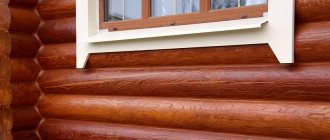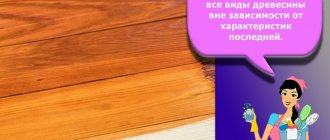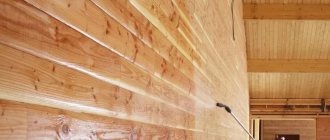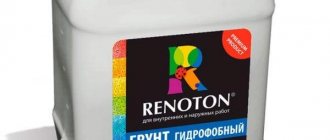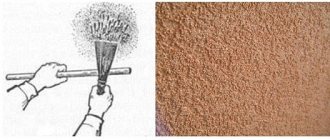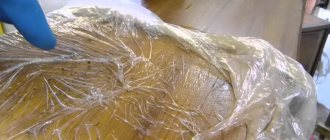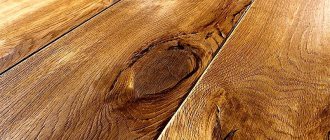Various paint and varnish materials can be used to process wood, but most of them serve to create a top decorative and protective coating, which also covers the design. If wood stain is used, the result is completely different.
This material, which is called “stain” in a professional environment, allows you to give the desired color or shade, without hiding the beauty of the wood, but, on the contrary, more clearly showing its pattern and revealing all its beauty. Skillful use of stain can enhance any piece of furniture or other wood product.
What is wood stain
During operation, aesthetic indicators deteriorate, wooden surfaces are deformed and destroyed. Under the influence of external factors and loads, the material swells or shrinks, rots, cracks, warps and fades. To preserve the original color and structure of the wood, staining is performed.
Stain or stain is a caustic brown liquid intended for deep impregnation of wood material in order to update or change the shade, as well as to increase the protective properties.
Unlike paints and enamels, the special composition does not form a film on the treated areas, which preserves the natural texture of the wood, making it more prominent. The degree of penetration of the composition and the intensity of the shade depend on the level of density of the texture layers and the natural color of the wood, as well as the quality of the product used. Modern stains protect against woodworms and mold, and extend the life of treated wood.
Types of stain
Stains cover any wooden surface. When choosing an impregnation, you need to take into account the composition and purpose, because Not all products have wood-protective properties.
Nitromordant
Dyes based on organic solvents and nitro varnish solution. The compositions are resistant to water washout and ultraviolet rays. Used for interior and exterior decoration. Staining is done quickly so that stains do not form on the surface. The dyes have a strong, unpleasant odor and dry quickly, so they are suitable for processing small-area elements.
Water based
A large group of impregnations, presented in liquid formulations or in powder form. The main ingredient is water, so the product is non-toxic and harmless to health. A wide range of shades helps highlight natural wood color or create a deeper tone. The final color depends on the number of layers applied and the hardness of the rock.
Working with water-based stain on wood is easy, it is easy to apply and is instantly absorbed, but it raises the fibers on the board, which disrupts the appearance of the material. The treated surface must be sanded and varnished. Without an additional protective layer, moisture can penetrate and cracks may form.
Oil based
Mixtures of dyes diluted in oils. The impregnation is convenient to use at home; the composition is applied in even layers and dries quickly. Can be applied with any tools. Oil stain, penetrating into the structure of the material, does not lift fibers, and forms a protective film on the surface from moisture and temperature. Coloring pigments are resistant to abrasion, have high light fastness, and retain their brightness and original color for a long time.
Alcohol based
Quick-drying impregnations with aniline dyes have a pungent chemical odor. When painting by hand, difficulties may arise during application; after drying, greasy stains and washouts may form that are difficult to remove or tint. To avoid defects, it is recommended to use a spray gun. The dye is not susceptible to ultraviolet radiation, so there is no need to use varnish after staining.
Acrylic and wax based
The impregnating agents contain acrylic resins and natural wax. The color range ranges from natural shades to bright exotic options. Acrylic stain is fireproof, has no chemical odor, and dries quickly. Emulsions paint without stains, highlight the texture of the board, making the grain pattern more expressive.
Wax stains are used to cover painted wood. The compositions form a moisture-proof film on the surface, which protects against damage and premature wear. Treated areas must not be coated with polyurethane or two-component varnish.
Stain with whitening effect
Impregnations are made on the basis of hydrogen peroxide and acids, which add a whitish tint to solid wood. Such impregnations are used to treat the material before painting. By staining, a bleached, slightly discolored timber is obtained.
Defects and their elimination
Staining wooden furniture must be done extremely carefully, otherwise there is a high risk of defects forming that are quite difficult to eliminate. But if you know how to get rid of them correctly, then there shouldn’t be any problems.
The main defect is the formation of streaks. They arise as a result of applying a large amount of the mixture and its subsequent rapid drying. In this case, it is necessary to remove the layer of impregnation applied to the wood, then apply a new layer on it, which will soften it, and then remove excess impregnation with a rag.
After the wood stain has completely dried, it can be removed using paint solvents. Before this, the top layer is removed with sandpaper or a plane, since the solvent is not able to remove all the pigment.
The most difficult defect is spotting of the product. To remove it, the painted area is treated with a plane (this defect is not washed off with a solvent). In plywood, all face veneer must be removed. To avoid staining, it is better to use a gel stain or first apply a test layer on an unwanted piece of wood to see how the coating behaves on the desired surface. It is worth remembering that the impregnation must be stored in a place away from children.
Today there is such a variety of wood impregnating agents on sale that even a specialized specialist cannot clearly answer the question of what their fundamental difference is. If you read the instructions for the preparations, the conclusion suggests itself that most of them protect wood literally “from everything.” So why do you need wood stain? Is it only for toning it, as is commonly believed?
An analysis of all the properties of the preparations available on the market in this category for wood processing, and reviews on thematic sites allows us to determine exactly what can be achieved with their help. Depending on the composition and specific application, wood stains can solve the following problems:
- Wood tinting while maintaining its texture.
- Reliable protection of the material when other means are ineffective or their use is not economically feasible. Reasoning - stains are characterized by a greater depth of penetration, while being cheaper than paints, varnishes and a number of other preparations used for wood processing (at least 2.5 times).
- Imitation of another, more expensive breed.
- Wood bleaching. This is often done either during its restoration, or in preparation for painting (applying colored varnish).
- Protecting the material from rotting (antiseptic function) and destruction by wood-boring insects.
- Combining shades, creating the effect of surface finishing with different woods.
- Some stains strengthen its structure.
- Giving (partial) moisture-repellent properties to lumber.
- Any stain, regardless of composition, definitely increases the shelf life of wood.
But is it really that simple? Is it enough to buy any of the commercially available stains, and all problems with reliable wood processing are solved? A comprehensive answer can be obtained by familiarizing yourself with all the types of liquids in this group. By the way, stains are often called differently - stains - and they are used not only to protect and prepare for further use of natural wood, but also building materials based on it (plywood, MDF, fiberboard, OSB, chipboard).
Color spectrum
The stain is available in a wide palette of colors, allowing you to easily and quickly add a noble shade to a wooden surface or completely change the appearance of the solid wood. There are many colors of water stain, made in the following options:
- pine – makes the coating almost invisible;
- beech – emphasizes the texture, gives a natural warm shade;
- marigold - makes the material darker;
- oak – painted in a dark brown tone;
- mahogany - looks noble and rich;
- ebony – stain gives a visually antique texture, emphasizes reliefs and stripes;
- light walnut – retains natural color, often used to protect wood;
- cherry – light red or rich dark burgundy shade;
- bleached oak – painted white;
- fern – has a pleasant green tone;
- wenge - a noble, gloomy dark brown color with black splashes and veins;
- mahogany - after drying, the board becomes brown with a light red tint;
- plum – gives a pleasant dark pink color;
- black - often used to give an antique effect;
- lemon – yellow, when applied in several layers it becomes more contrasting;
- rowan - faint beige or pale pink color;
- maple – delicate peach;
- mocha – has a coffee tint;
- larch - available in dark yellow to orange shades;
- stained oak – has a matte tone;
- ash - gives a light pink tint;
- hazelnut – looks like a nut shell, used to achieve a deep effect;
- blue – reminiscent of wolfberries.
What effects can you create?
Various combinations of shades and compositions allow you to create interesting effects that will make the interior stylish and sophisticated:
- Aging effect. A dark-colored water-based stain is applied, and areas are carefully painted over so that there are no gaps left. After drying, a composition based on organic compounds is applied. The resulting shade is fixed with shellac primer and then varnished.
- Imitation of noble wood (pine, oak). It is performed by rubbing, so quick-drying compounds are not suitable for such work.
- Bright concentrated colors. Saturated shades are obtained by mixing 2 or more types. Blue stain combined with mahogany gives a purple color. The same shade is obtained from a mixture of mahogany and ebony. For the mocha color, plum and marigold are used, as well as walnut and rowan stain.
- Imitation of natural color without signs of processing. This effect is created by alcohol and water stains in shades of oak, ebony or pine. The color range of acrylic and wax stains changes the appearance of the stained board.
- Bleaching. Bleached surfaces are created from 2 different compositions. First, white wood stain is used to create a continuous coating. After drying, all cavities, reliefs and pores are filled with oil stain with the addition of hard wax. A thin wax film highlights all irregularities in black or gray, the rest of the area remains whitish.
- Colored stains. First, the main background is applied, then strokes are made over it with other colors of the stain. At the final stage, colorless varnish is applied.
- Blue, burgundy and black wood stains help create unusual combinations when arranging the interior. An interesting effect can be achieved by making a blue floor and burgundy furniture elements.
Work technology
The method of applying it depends on the type of stain. Typically, a brush, spray, swab, or sponge are used for painting work. It is better to treat unsmooth and large-sized bases with a spray gun (in the first case, do not use a brush so that there are no fallen bristles left on the wood). To use a sprayer, choose a lighter shade of stain: the layer will be thicker, making it appear darker.
Oil products are usually applied with tampons and sponges. Instead of buying, you can make such a device yourself: wrap cotton wool in a cotton cloth or simply cut off a piece of foam rubber. Water and alcohol stains are applied using brushes with synthetic bristles. The quality of the tool must be high, otherwise it will “lose” bristles.
Before the main stage of work, a test painting is always carried out to clarify the required number of layers to obtain the desired shade. The procedure is as follows:
- take a board of the same type as the base material and polish it;
- cover the product with impregnation;
- leave until dry;
- apply another layer to 2/3 of the board;
- after drying, treat another 1/3 of the workpiece with a third layer;
- As it dries completely, evaluate the appearance of all three areas and select the optimal shade.
Surface preparation
Impregnation should always be applied only to a clean base. There are usually no problems with a new product. But sometimes you have to process old wood, which has been damaged during long use, has been varnished or painted. Before working with wood, it is necessary to remove the layer of old coatings. You can remove varnish and paint using special removers. If this is difficult, mechanical or thermal effects will come to the rescue:
- First way. Apply an organic solvent to the base, then go over it with a spatula, scraping off the paint.
- Second method (for a thick layer of paint). Moisten the surface generously with the remover, cover with cellophane, remove it after a day and treat the base with a knife, spatula, or sanding machine.
- Third way. Warm up the product with a hair dryer, then remove the paint with a spatula. You can use a blowtorch, but the wood must first be moistened with water.
The remaining coating is sanded off with sandpaper. If there are cracks on the base, they must be sealed with wood putty, and after drying, sand the treated areas. All protruding knots should be cut down, protruding fibers should be eliminated with sandpaper. The raw wood must be allowed to dry thoroughly, otherwise the stain coating will not be of the required quality.
Coniferous species will have to be deresined before applying stain. To do this, you need to prepare a special composition, apply it liberally to the wood, and after 30 minutes, rinse and dry. Here are the recipes for such compositions:
- 750 ml of water and 250 g of acetone;
- 1 liter of water and 50 g of caustic soda;
- 1 liter of water and 50 g of potassium carbonate, 60 g of soda ash.
Applying stain to the surface
Before you start tinting the wood, all untreated surfaces must be covered with film or their edges must be covered with masking tape. The technique of treating wood with stain is almost no different from conventional painting. It is only important to act quickly so that the coating is more uniform. Don't put too much product on your brush; it will leave unsightly streaks.
Woodworking should always be parallel to the direction of the wood grain. The stain is first diluted to the desired consistency, if required. Here are other recommendations for tinting surfaces:
- you cannot proceed to processing a new section without completely painting the previous one;
- at the junction of two sections, it is important to ensure that the layers of stain do not overlap each other;
- the most beautiful coating is obtained when using the spraying method: the risk of stains and unpainted areas is minimal;
- rubbing oil stain with a rag gives the effect of oak even on the cheapest material;
- the first layer is always made the thinnest, it will create a base and reduce the consumption of material for subsequent layers;
- most often, to give the optimal color, 2-3 layers of stain are required, each of them thoroughly dried.
After the water sealant dries, raised wood fibers inevitably appear on the surface. They need to be cleaned with a coarse cloth in a longitudinal, diagonal direction.
Applying stain to stain
If you want to update the color of the wood, you can purchase another stain and apply it over the previous one. It is only important that its tone is not lighter, otherwise the desired color will be difficult to achieve. Typically, re-tinting requires only 1-2 layers of stain.
Stain on varnish or paint
Since varnish and paint create a dense protective film on wood, stain will not be able to penetrate the fibers, saturate the material and highlight its structure. The product will simply dry on the layer of varnish or paint, staining the surface. First you need to completely remove the previous coating and only then apply the stain.
Consumption and drying time
Consumption per 1 m2 depends on the type of stain, as well as on the quality of wood preparation and method of application. So, for acrylic stain this figure is about 120 g/sq.m. m, for oil – up to 150 g, for water and alcohol – from 50-70 g. Drying time also depends on the type of stain. Water and oil coatings dry in 10-14 hours, alcohol coatings dry almost instantly, acrylic coatings dry in 60 minutes, wax coatings dry in 10-15 hours. For oil-based coatings, the time before use should be at least 2-4 days.
How to make it yourself
Making your own stain helps you experiment with shades and get the most unexpected results.
Based on plant materials
Methods for making wood impregnation:
- The bright red color is obtained from a strong decoction of onion peels.
- The brown color is made from dried walnut skins. The shells are crushed into powder, boiled for 10 minutes in water, and filtered. Dissolve 1 tsp in the finished broth. soda To make a red impregnation, potassium bichromate is used instead of soda, and vinegar essence is used for gray impregnation.
- Birch trees are painted red using a decoction of larch bark.
- Light brown comes from nut shells and apple tree bark.
- Black stain is obtained from a boiled mixture of oak, willow and alder bark.
- Anthracite black is made from vinegar, oak bark or walnut.
- The golden-yellow tone comes from a decoction of unripe buckthorn fruits.
From coffee, tea and vinegar essence
Using strong tea, coffee beans and vinegar, you can create a wenge, Oregon or pine stain:
- Mixing equal amounts of ground coffee beans and baking soda produces a rich brown color.
- Light wood can be treated with strong black tea.
- You can make a black-gray stain using metal nails and acetic acid. The nails are placed in a container and filled with acid for 5-7 days. Insist in a dark place.
Based on chemical components
Impregnation preparation options:
- The board becomes brown after treatment with slaked lime solution.
- The dark cherry tone is imparted by a solution of potassium permanganate. You need to dilute 50 g of potassium permanganate in 1 liter of warm water.
- A deep yellow tint is achieved by treating the material with a decoction of barberry roots with the addition of alum.
- Green wood is obtained by combining decoctions of poplar shoots and oak bark.
- The timber turns dark brown from the juice of wolfberries and copper sulfate. Berries with Glauber's salt give a scarlet color, with potash - green, with soda - blue.
- Black stain for oak and mahogany is made from potassium dichromate (chrompic). Pour orange powder into a glass bottle, add hot water and shake until completely dissolved.
- The green-herbal color is obtained by adding 50 g of verdigris to the vinegar essence. The mixture is boiled for 10 minutes.
With whitening effect
Stains are used as a base before painting wood. Whitening impregnations can be prepared in the following ways:
- Based on oxalic acid. Staining is performed on light or bleached wood. To prepare, add 9 g of acid to 180 g of warm water. After application, the surface is washed with a solution: 10 g of soda and 30 g of lime are diluted in 200 g of water.
- Based on hydrogen peroxide. Not suitable for dark rosewood, mahogany and oak. For bleaching, use a 30% peroxide solution.
Tips for choosing
When choosing the composition and color of the stain, it is necessary to take into account that when applying the same product to different types of wood, each time there will be a new shade. Tips for choosing impregnation:
- Porous and soft woods absorb stain well: hardwoods are deeply and quickly soaked; conifers cannot be changed, but only given a slight tint.
- Dark wood will become even darker after staining. Popular stains include beech, teak, oak and cherry.
- The natural beauty of the board will be emphasized by colorless stain.
- For whitening external surfaces, white wax stain or alkyd-based compositions are suitable.
- The consistency of the composition affects the intensity of the shade. A mixture that is too thick will make it difficult to apply, but will give a richer color. Liquid stains will not provide the desired depth of shade and must be applied in several layers, but in this case the wood will be painted evenly.
- Pigment stains fill the ribs and reliefs of the wood, leaving the rest of its surface less painted.
- For structures with cracks and irregularities, it is necessary to choose special priming compositions with a porosity filler.
- Alcohol compositions are convenient for treating furniture and doors; stains may form when painting stairs and parquet. Stain looks beautiful on walnut and mahogany pieces. Stained paint is not suitable for elements made of spruce, poplar, cherry, birch and pine. To reduce the appearance of possible defects, the top of the object is processed first.
You need to select the stain on a sample of the board that is to be processed. Otherwise, you may get the wrong result.
Finishing wooden surfaces with stain: tips from TBM-Market specialists
To make the result pleasing, before starting finishing work you need to remember the simple rules of wood processing:
- To increase the depth of penetration into wood and improve adhesion to the surface, the composition should be slightly heated to a temperature of 36-38°C.
- The stain can be applied in different ways: rub in in a circular motion using a swab and longitudinally using a roller and brush.
- Wiping off excess must be done only along the fibers.
- To avoid blots and drips, do not dip the brush or swab into the solution too much.
- Do not apply a second layer of composition on the first one that has not dried.
- The ends and sections of wood that actively absorb the composition must be subjected to more intensive processing.
- Vertical surfaces of doors, panels, and walls should be coated starting from the bottom to prevent stains from being absorbed into unpainted wood.
- The procedure for applying layers can be repeated several times until the desired tone is achieved.


